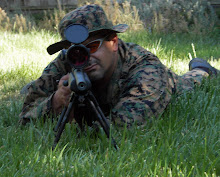One thing I struggle with continually in my infrequent collimation attempts is understanding the direction that I need to adjust in order to make the correct movements of the secondary mirror.
Articles on SCT collimation say to look into your eyepiece and reach around the front of your telescope putting your index finger near the front of your telescope pointing towards the center. While a great (and easy) thing to describe, this is a very difficult thing to do, especially if your telescope is wedge mounted.
The distance from your eyepiece to the front of a wedge mounted telescope (alt-az is much easier as it is a shorter distance) is pretty far making it pretty much out of reach unless you have some pretty long arms. ;-)
So thinking about this more, I wondered what I could do to mimic the pointing characteristics needed during collimation, without reaching around to the front of the scope with my hand.
Here were the characteristics I considered:
- stability (it needed to stay put in one place until I removed it)
- mobility (it needed be able to be put on and removed as necessary)
- size and weight matters (needed to be something I could put in pocket or toolkit)
it also needed to reasonably perform the function necessary, meaning that it should obstruct enough light to mimic a finger but not enough that it takes away from the collimation efforts.
I decided to try out a very simple mechanism to do this, choosing an ice cream stick *, an 'alligator clip' and a wood screw**. I also decided to use epoxy to bind the stick / 'alligator clip'.

Now, when I use the 'collimation helper'

This is a representation of what to expect when peering through your eyepiece while collimating your telescope using this device, the straight line emanating from the outer circle is the 'collimation helper'.

Next step will be to paint it, probably flat black but that is only cosmetic, it is really unnecessary as it will work just fine without any paint.
Notes:
* any ice cream stick should work, I chose a thicker one to ensure I had a decent obstruction.
** any type of screw should do, as long as it fits snugly within the 'alligator clip'
Update: Never bothered to color the instrument, worked as expected even without coloring. Choosing a fatter stick worked well as it enabled me to really see it in the focal picture. One modification that I did and would highly suggest is making the end (toward the center of the view) pointed, I worked out what the center should be and then employed my 'dremel tool' on it to give it a pointed end, leaving the rest of the contour in place, this minor adjustment gave me something to focus on and assisted in making the final adjustments.
Happy Photon Hunting!



